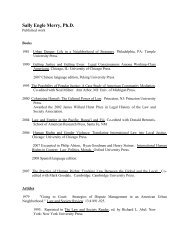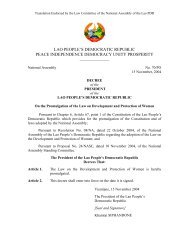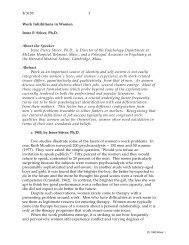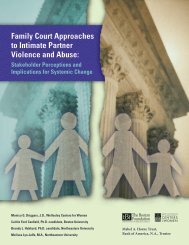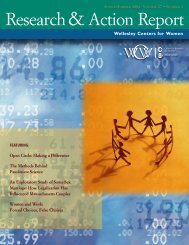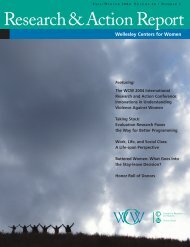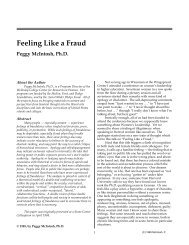Preview This Publication - Wellesley Centers for Women
Preview This Publication - Wellesley Centers for Women
Preview This Publication - Wellesley Centers for Women
You also want an ePaper? Increase the reach of your titles
YUMPU automatically turns print PDFs into web optimized ePapers that Google loves.
Dysfunctional Families and<br />
Wounded Relationships — Part II<br />
Irene P. Stiver, Ph.D.<br />
About the Author<br />
Irene Pierce Stiver, Ph.D., is Director of the<br />
Psychology Department at McLean Hospital, Belmont,<br />
Massachusetts; a Principal Associate in Psychiatry at the<br />
Harvard Medical School; and a Visiting Scholar at the<br />
Stone Center, <strong>Wellesley</strong> College.<br />
Abstract<br />
<strong>This</strong> paper will discuss a number of different<br />
strategies which people who grew up in dysfunctional<br />
families used to stay out of relationships. Alcoholic, incest<br />
survivor, and Holocaust families provide contexts to explore<br />
some important features of these strategies. They will also<br />
illustrate how secrecy, the emotional inaccessibility of<br />
parents, and parentification of children often significantly<br />
hinder the development of authentic relationships both in<br />
and out of the family.<br />
<strong>This</strong> paper was presented at a Stone Center<br />
Colloquium on November 1, 1989.<br />
© 1990, by Irene P. Stiver, Ph.D.<br />
In a previous paper, “Dysfunctional Families<br />
and Wounded Relationships — Part I,” I reviewed<br />
several characteristics of dysfunctional families,<br />
namely secrecy, emotional inaccessibility of parents,<br />
and parentification of the children (Stiver, 1990).<br />
Three different dysfunctional family contexts —<br />
Holocaust survivor, alcoholic, and incest survivor<br />
families — illustrated how these characteristics<br />
contributed to major disconnections in the children<br />
growing up in these families.<br />
Jean Baker Miller’s paper on “Connections,<br />
Disconnections and Violations” has given us a new<br />
vantage point to understand how family dynamics<br />
contribute to pathological development of children<br />
(1988). Let me summarize briefly the key processes<br />
which Miller believes lead to signficant disconnections<br />
in dysfunctional families.<br />
Disconnections<br />
When the child’s expression of her thoughts and<br />
feelings is not heard nor responded to, when she feels<br />
that how she is or what she expresses has no impact<br />
on the important people in her life, when she<br />
experiences a profound sense of powerlessness in her<br />
relational interactions, and when her painful feelings<br />
cannot be shared with another person, there are<br />
profound consequences, in a marked erosion of trust,<br />
in the impaired capacity <strong>for</strong> empathy, and a lack of<br />
empowerment.<br />
Most importantly, a child growing up in these<br />
nonrelational settings learns to alter her inner sense of<br />
herself in the attempt to deal with the images imposed<br />
on her by others. She also attempts to adapt her selfimage<br />
to her understanding of the meanings of the<br />
neglect and/or violations she endures from others.<br />
More and more of the child’s experience is split off or<br />
“walled off,” leaving her with a constricted and<br />
negative image of herself and others.<br />
1<br />
(C) 1990 Stiver, I
In these dysfunctional settings, children learn<br />
how to stay out of relationships while behaving as if they<br />
are in relationships. They do this as the only mode of<br />
survival. For these children, exposing their<br />
vulnerabilities through being authentic and empathic<br />
in interactions with others is dangerous. <strong>This</strong> danger<br />
leads them to develop strategies to hide their<br />
vulnerabilities and, thus, to avoid more genuine<br />
relational connections. At the same time, a compelling<br />
need <strong>for</strong> some kind of connection to another person<br />
often results in destructive and wounded<br />
relationships.<br />
Staying out of relationship<br />
In this paper I will explore these strategies of<br />
staying out of relationship in the context of the same<br />
three dysfunctional families I discussed earlier. There<br />
are many ways not to participate authentically and<br />
mutually in relationships. For example, there are<br />
those who manage through withdrawal and avoidance<br />
or over-investment in work to maintain distance from<br />
others; or those who become phobic and restrict and<br />
constrict their range of functioning and thereby limit<br />
their contacts with others; or those who develop<br />
somatic symptoms which totally preoccupy them,<br />
leaving little energy or available emotion <strong>for</strong><br />
interpersonal relationships.<br />
However, I will focus on the particular strategies<br />
developed by those who make strenuous ef<strong>for</strong>ts to<br />
make connection with others, but remain unable to<br />
engage interpersonally in a genuine and empathic<br />
fashion. Although these people are not always aware<br />
of the discrepancy between the wish <strong>for</strong> connection<br />
and the nonrelational qualities of their interactions<br />
with others, they report that underneath they often<br />
feel crazy, isolated, and out of touch with those<br />
around them. Some people feel a generalized level of<br />
anxiety and unease without knowing why. Others are<br />
much more aware of their dissatisfaction with their<br />
relationships and are more or less in touch with the<br />
source of their distress; many come into therapy as a<br />
consequence of this awareness.<br />
One adult child of an alcoholic family reports:<br />
Our whole life was an illusion. We looked like<br />
the all-American family, we had upper middle<br />
class income, we had people who came over to<br />
the house, they weren’t friends but they looked<br />
like friends. I was on the swimming team, my<br />
sister was a cheerleader, but if anybody had<br />
taken the time to look at any of us, none of us<br />
had any intimate relationships or ever talked to<br />
anybody about how they felt...we were<br />
2<br />
chameleons, put us in a situation, give us five<br />
minutes to watch the players and we adapt....we<br />
will always feel outside of it but we can present<br />
ourselves however we need to present ourselves<br />
in order to exist. (V., 1987, p. 39)<br />
Another adult child said, “I was addicted to<br />
having a relationship where I was in control; I was<br />
addicted to having somebody but not being in a<br />
relationship.” She added, “Those are two different<br />
things” (V., 1987, p. 11).<br />
I suspect that gender differences may be<br />
significantly associated with the different ways used<br />
to stay out of relationship. That is, women from<br />
dysfunctional families probably make greater ef<strong>for</strong>ts<br />
to stay in connection than do men, albeit often through<br />
superficial and nonauthentic modes of placating and<br />
accommodating others. Men from such families may<br />
more often take routes of avoidance, compulsive<br />
activity at work or sports or the like, and make fewer<br />
ef<strong>for</strong>ts to establish connections.<br />
Strategies<br />
I will now describe three broad categories of<br />
strategies which I believe are expressed in different<br />
ways in the three family contexts I have chosen to<br />
examine. They are (1) various <strong>for</strong>ms of emotional<br />
disengagement which include the extremes of<br />
“psychic closing off” (Lifton, 1968), dissociative states,<br />
as well as the use of substances which numb affect; (2)<br />
role-playing which refers to assuming a persona, a<br />
style of per<strong>for</strong>ming which seems adaptive and<br />
appropriate, but is not experienced by the person as<br />
authentic; and (3) replication of old interactions and<br />
family dynamics which are compelling and<br />
unrelenting.<br />
These categories obviously do not cover all<br />
possibilities, and they overlap to some extent. I think,<br />
however, that they help to illustrate how secrecy, the<br />
emotional inaccessibility of parents, and the<br />
parentification of a child in a family often significantly<br />
hinder the development of empathic capacities, selfworth,<br />
and a sense of empowerment in relationships.<br />
The message explicitly or implicitly given to the child<br />
is that she is not allowed to be authentic.<br />
Although the children growing up in these<br />
households experience considerable pressure to stay in<br />
the family and not to move out into a world labeled as<br />
dangerous and hostile, relationships in the family are<br />
more illusory than real since there is a lack of<br />
mutuality in sharing affects, in<strong>for</strong>mation,<br />
understanding, and caretaking. The resistance to<br />
leaving the family is powerful <strong>for</strong> many reasons. The



